
Frida Kahlo wore her heart on her sleeve, though not the way one might think. In real life, as on the canvases of her many self-portraits, Kahlo used fashion to channel her physical and emotional insecurities into statements of strength, heritage, and beauty. Yet for nearly 50 years, her personal wardrobe remained hidden to scholars and fans alike, locked away shortly after Kahlo’s death in 1954.
“Because of its geometry, it was the perfect dress to disguise Kahlo’s imperfections and distinguish her from her famous husband.”
When Kahlo passed just after her 47th birthday, her husband and fellow artist, Diego Rivera, began placing her most personal belongings into a bathroom of their Mexico City house. Upon Rivera’s death in 1957, their home, also known as La Casa Azul or “The Blue House,” became the Museo Frida Kahlo. But shortly before Rivera died, he gave instructions to a close personal friend, Dolores Olmedo, that the room containing Frida’s wardrobe should stay locked for the next 15 years. Olmedo took Rivera’s request so seriously that she ultimately decided to keep the room sealed until her own death in 2002.
During the last decade, the museum has finally been able to catalog and organize the bathroom’s contents, which included hundreds of documents, photographs, and artworks, in addition to around 300 articles of clothing and personal objects, from a pair of earrings Picasso gave Kahlo to her customized prosthetic devices. Just last November, in collaboration with Vogue México, the museum opened the first exhibition of Kahlo’s personal garments, presenting her attire through the lens of disability and female empowerment, as well as her continued influence on fashion. The exhibition focuses on the ways Kahlo used her iconic style, often composed of traditional Tehuana garments, to project her feminist and socialist beliefs while also masking her debilitating injuries.

Top: Frida Kahlo wearing a signature colorful look. Photo by Nickolas Muray. Above: Frida displays the three elements of Tehuana dress in 1939—the floral headpiece, square-cut blouse, and long skirt.
Curated by Circe Henestrosa, a native of Mexico City and the director of the fashion program at Singapore’s Lasalle College of the Arts, the show will run for a complete year, until November 22, 2013. The exhibition title, “Appearances Can Be Deceiving: Frida Kahlo’s Wardrobe,” is a reference to a drawing discovered in this secret archive, which depicts the physical impairments of Kahlo’s naked body through the sheer outline of a dress. In addition to the museum show, Henestrosa documented Kahlo’s belongings with photographer Ishiuchi Miyako for a book, called simply “Frida,” to be published later this spring.
Recently, Henestrosa gave Collectors Weekly an inside peek at Kahlo’s hidden wardrobe and the artist’s complex relationship with fashion.
Related: The True Story Behind Frida Kahlo’s Iconic Style
Collectors Weekly: How did you become involved with this exhibition?
Henestrosa: I actually brought the project to the museum. When I learned that Frida Kahlo’s wardrobe was discovered, I was living in London and doing my M.A. in fashion curation. My curatorial thesis was focused on her wardrobe and how Kahlo built her identity through disability and elements of tradition. All the experts had said that she wore this Tehuana clothing to please Diego Rivera. While I don’t deny that they were an inspiration to one another, I think there were intrinsic reasons why she chose that dress to build her identity. And that’s when I started looking more closely and found all these clues.
For example, when Kahlo was 6 years old, she had polio, so her right leg remained shorter than the other. She describes in her diary how she used to wear three or four socks, building a support in her shoe, like an extra heel to level her right leg. She also started wearing long skirts when she was young, another interesting clue. Kahlo made a conscious effort, using dress to disguise her imperfections, even when she was very little. She was solving functionality problems, really, through fashion.
We also discovered a photograph of her maternal family all dressed in the Tehuana tradition. That photograph was key to our research, because it shows that Kahlo had this Tehuana legacy way before meeting Rivera.
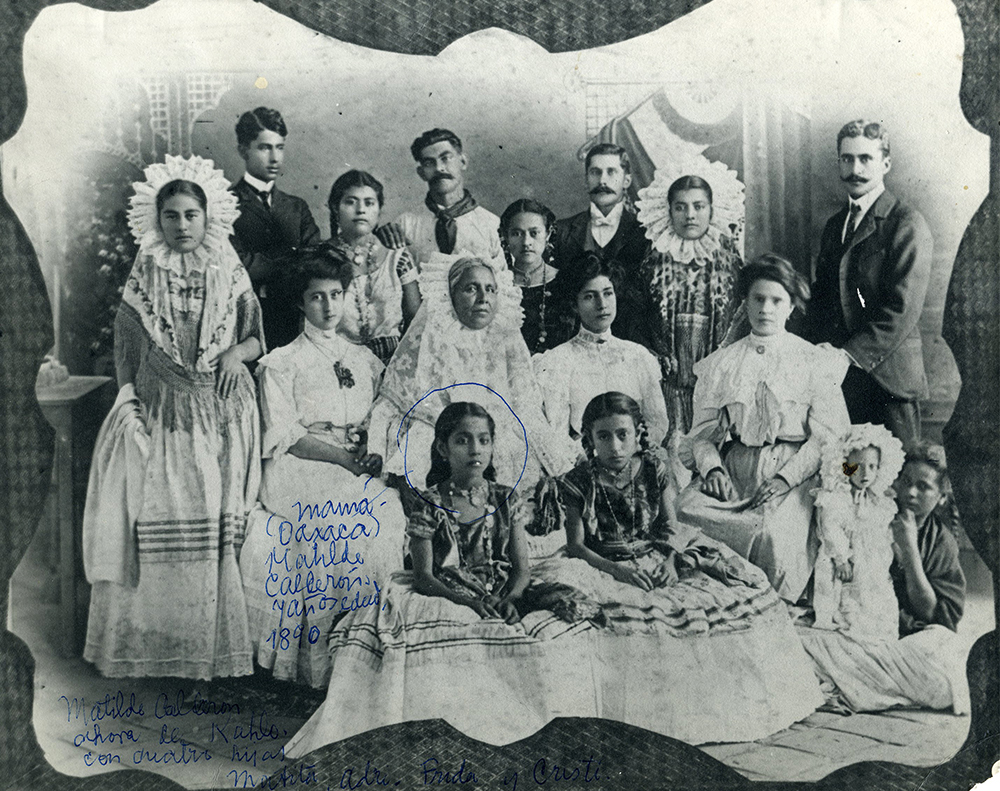
In this 1890 portrait, Kahlo’s maternal family wore Tehuana style clothing. Frida’s mother, Matilde Calderón, is circled at center. Courtesy Museo Frida Kahlo.
Collectors Weekly: What is the Tehuana style?
Henestrosa: The Tehuana dress comes from the Tehuantepec Isthmus, which is in the southeast part of Mexico in the state of Oaxaca. If you go to the Tehuantepec Isthmus, all women are dressed in this traditional style. It’s composed of three parts.
“The more she was suffering or worse she was feeling, the more adornment she would wear.”
You have a very heavy headpiece made with pleats and flowers and ribbons, so the adornment is concentrated around the head. Then you have the huipil, which is a short blouse, usually accompanied by a lot of jewelry, and finally a long skirt. The Tehuantepec Isthmus is a matriarchal society, so that means women dominate the culture; they administer the society. Frida Kahlo didn’t just choose any dress from Mexico. She chose a dress that symbolizes a very powerful woman.
When I started my research, I was concentrating on textile embroidery on velvet, but I realized that her wardrobe only had one velvet skirt and one velvet blouse. Most of her wardrobe was made of cottons and silks, of course, because they are lighter fabrics. The velvet is so heavy, that her body couldn’t sustain or carry it. Most of the archive is actually decorated with cross stitching, or a technique called “cross chain.” This is a style the indigenous women in the Tehuantepec Isthmus wear for everyday life, while the velvets are reserved for parties or more formal attire.

A selection of native Tehuana looks on view at the Museo Frida Kahlo exhibition. Photo by Miguel Tovar.
The construction of the dress is also very important, because the adornment is concentrated from the torso up, with the jewelry and the headpiece and the flowers and ribbons. The viewer will always look at Frida and concentrate on her face and torso, distracting you from her legs, which are covered with the long skirt, and her broken body, which is underneath. Remember, she had an almost fatal accident when she was 18, in 1925.
Collectors Weekly: It was a traffic accident, correct?
Henestrosa: Exactly. When she was traveling from school back to her house, she was in a bus that collided with a tramway, and one of the metal handrails in the bus pierced her body from the left side, crossed through her womb, and perforated her vagina. She was left almost dying on the street, covered in blood and naked because the crash had ripped her clothes off. It was really like a rape; it was horrible. The fact that she survived was a miracle.

Left, a drawing from 1932, “The Abortion,” addresses Kahlo’s inability to conceive children following the bus accident. Right, Kahlo decorates one of her many plaster corsets in 1951.
That was the beginning of her career as an artist, because she spent about a year in bed, recovering with all these plaster casts, corsets, and artifacts that were putting her body back together. It was the beginning of a great artist but also of the deterioration of her body, which lasted until 1954 when she died.
Kahlo had 22 surgical interventions after her accident. These surgeries were concentrated between her spine and her right leg area, until the point when she had her leg amputated in 1953. For the rest of her life, she had to wear a series of plaster cast corsets and leather corsets that helped her sustain her body.
Collectors Weekly: Why did Kahlo adopt the Tehuana style?
Henestrosa: That’s what the exhibition works to explain. By the time she decides to wear this dress, it solves different things for her. When she married Rivera in 1929, she was 20 years younger than him, and he was already one of the most important Mexican artists. This is exactly the period when José Vasconcelos, the Mexican Minister of Education, was trying to promote all the traditional Mexican values.

Kahlo’s traditional attire particularly emphasized her Mexican heritage in New York, circa 1946. Photo by Nickolas Muray.
At the time, the popular style was to dress like people in Hollywood or in Europe. We used to have a president that was obsessed with Paris, so anything French was trendy. But Vasconcelos felt that all the traditional Mexican values had been lost, so he commissioned all these Mexican artists to paint massive murals. Mexican people are very visual, so he wanted to tell the story of Mexico through these murals, to make people feel connected to and proud of their history. Similarly, Frida Kahlo also wanted to portray her Mexicanidad, or Mexican cultural identity. She wants to feel part of the pueblo, of the people.
After she and Rivera got married, they started traveling. From 1931 to 1933, they were in San Francisco, and then they went to New York. Kahlo went to Paris in 1939 for her first group exhibition where she showed her self-portrait “The Frame” which was purchased by The Louvre. But Mexico becomes an artistic center around the ’40s, and once the Surrealist artists and Trotsky arrived in Mexico, the Rivera house became the place to be for anyone interesting from abroad.
When she decided to wear this Tehuana dress in the 1920s, she wanted to portray her socialist political beliefs and to look very Mexican. Her reasons went far beyond wanting to please Rivera. At the same time, because of its geometry and composition, it was the perfect dress to disguise her imperfections and distinguish her from her very famous husband. Who else was dressing like that at the time? Nobody.
Collectors Weekly: Did she update this native style in any way?
Henestrosa: She did some small interventions to her Tehuana pieces but these were mostly variations on embroidery or flowers or other little techniques she would put here and there. But no, she didn’t really alter it. I think she liked it the way it was. It showed her Mexican heritage, and she felt very proud to wear it. When you wear this type of dress, it’s amazing—you really feel like a queen. It’s a very special dress.

Frida holding an Olmeca figurine at her home, La Casa Azul, in 1939. Photo by Nickolas Muray.
Collectors Weekly: Were there other cultural influences in Kahlo’s wardrobe?
Henestrosa: Most of the archived clothing is of the Tehuana style, but she had pieces from Chiapas and other regions of Mexico, as well as European pieces. If you look at a painting like “Las Dos Fridas,” one is dressed in European attire and the other one is in the Tehuana dress. “The Two Fridas” is one of Kahlo’s most famous paintings and the largest one she made. This painting shows exactly what her wardrobe was, with European pieces and Mexican pieces, and also how her heritage is mixed. She’s a mestiza. Her father was German and her mother was Mexican, so she was a mixed-race kid. Originally I wanted to show this painting in dialogue with the dresses because it was a very obvious comparison.

In Kahlo’s painting “Las Dos Fridas” from 1939, she is shown wearing both the Tehuana and European fashions, which both completely conceal her damaged leg.
But the important thing is that the construction of her outfits are always the same: She would wear a headpiece and she might wear a European blouse and then a long skirt. The basic construction of the Tehuana dress—adornment on the head, a short blouse, and then the long skirt—is the form she always built from, whether she was wearing a European skirt or a European blouse or a combination of both.
Collectors Weekly: Was Frida recognized in the fashion world during her lifetime?
Henestrosa: I read everywhere, even in Kahlo’s biography, that she had been photographed for a cover of Vogue. So I went to Vogue‘s archives in Paris but couldn’t find this famous cover. But I did find a spread from October of 1937, made by Toni Frissell for American Vogue. Kahlo’s style was so striking that it attracted the attention of the editor-in-chief even then.
Collectors Weekly: How did you present Kahlo’s style in the exhibition?
Henestrosa: I wanted to make sure that it wasn’t an exhibition about Kahlo’s artwork, but about her. I worked with the designer of the exhibition, Judith Clark, for three years, and the headpieces were made by Angelo Seminara, who won British stylist of the year in 2012. Because of space limitations, and also for conservation purposes, I decided to rotate the nine looks that are on display every five months. It’s like a window display that changes each season.
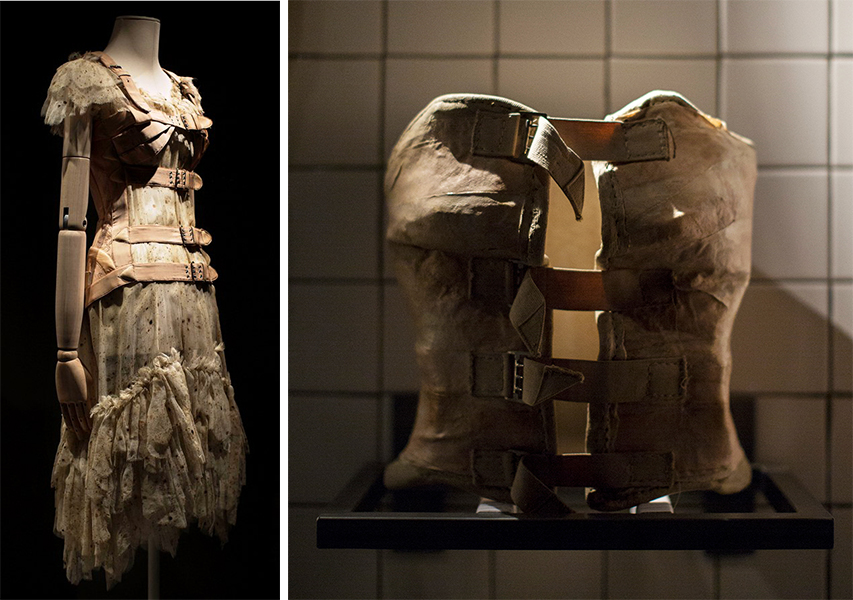
On the left, a Gaultier corset dress from 1994 that was inspired by Kahlo’s plaster supports, like the one shown at right. Photos by Miguel Tovar.
The exhibition starts with origins, which is the disability wall. All her orthopedic devices are displayed on this tiled wall, which reminds us again of the bathroom and where these objects were discovered. Then you go to Room 2, which shows Kahlo’s various looks and explains all the elements of tradition, and how she caused a sensation. For example, when she was walking around in San Francisco in the ’30s, kids used to ask her, “Hey, where’s the circus?” Kahlo just laughed, of course, because she did stand out—adorned in this colorful attire with so many necklaces and accessories. I used a cabinet of curiosities to display her beautiful shoes, because they give you so much information about her.
Lastly, we use two more galleries for the contemporary interpretations, where I display pieces by Jean Paul Gaultier, Rei Kawakubo for Comme des Garçons, the Welsch artist Dai Rees, and then the 2010 Givenchy couture collection, made by Riccardo Tisci. He did the most extraordinary collection inspired by Frida, as if he had already seen the drawing of “Las Apariencias Engañan,” or “Appearances Can Be Deceiving.” This drawing was discovered in her archive in 2004, and is actually the starting point of the exhibition. It displays the layers of her identity: She’s naked wearing her corset and surrounded by the silhouette of the Tehuana dress, almost as a phantasmagoria.

Left, Tisci’s designs for Givenchy’s 2010 collection echo the corsetry and transparency of Kahlo’s 1934 drawing “Appearances Can Be Deceiving,” which shaped the entire exhibition. Photo by Miguel Tovar.
The Givenchy collection has a lot of lace and whites, linking the materials to Kahlo’s wardrobe, and Tisci really defines the skeleton. I think that collection is based more on Kahlo’s painting “The Broken Column,” but it’s incredible how well he captured the “Appearances Can Be Deceiving” drawing as well. When we sent an image to him, he was like, “Whoa!” He really got it.
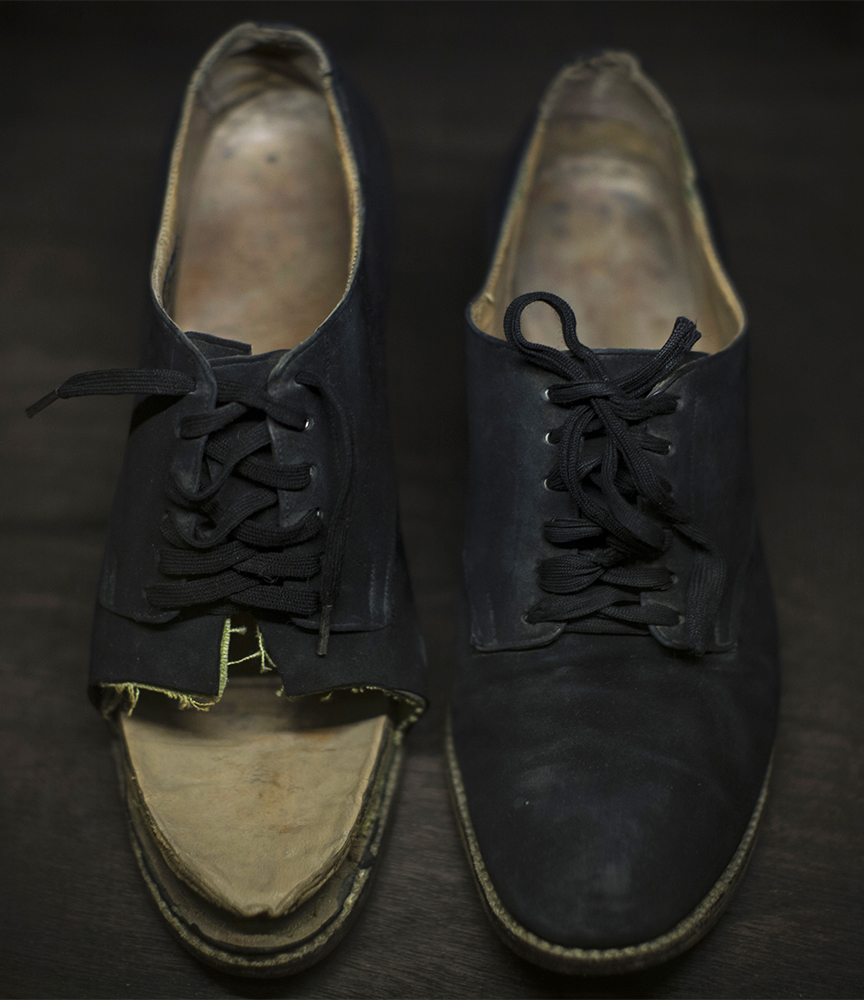
Kahlo’s shoes with the right toe removed to make her injured foot more comfortable. Photo by Miguel Tovar.
Through the materials used for the exhibition, we’re also trying to remind the viewer of Kahlo’s archive. For example, in the disability section we used the tiled wall, but we also used metal bars that remind us of that bar that pierced her body in the bus accident. The cross stitch or chain stitch pattern, made in little “X” shapes, is also repeated in these metal crosses around all the cabinets.
And in the contemporary section, where the new corsets are displayed, we used the tiles again on the floor, as though they’re taken to the runway. The contemporary section is also in more natural colors, creams and whites and neutrals. Everyone relates Kahlo with a lot of color, so the only part of the exhibition with bright color is her archived pieces.
Collectors Weekly: What is the significance of Kahlo’s prosthetic artifacts?
Henestrosa: Those objects are really important because she struggled with her right leg for the rest of her life. The black shoes have a deliberate cut to allow her foot to breathe, because she eventually developed an ulcer and two of her toes had to be amputated.
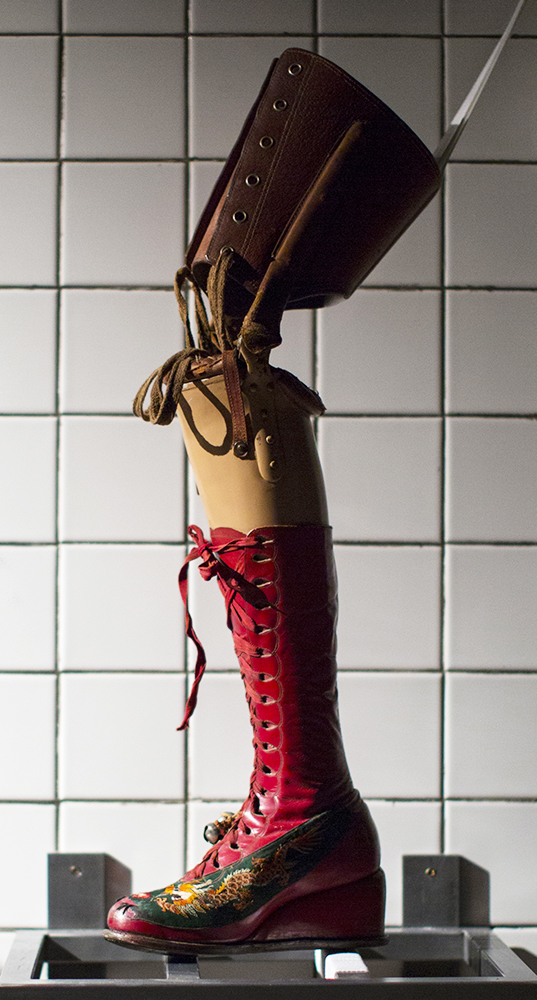
Frida’s stunning prosthetic leg from 1953, finished with a red leather platform boot. Photo by Miguel Tovar.
Then in ’53, she had her right leg amputated. She had handled Rivera’s infidelities and even her broken body. Through her paintings, she could express a lot of herself and her suffering. But I don’t think she ever recovered from losing her leg. When she actually had that leg amputated, she fell into this deep depression. You can see in the last pages of her diary, she’s very afraid. She wrote, “It’s confirmed. I’m going to get my leg cut.”
I think psychologically, it really affected her, because she really focuses on the leg in her writing: When she’s going to have the operation, after the operation, how sad she feels. It took Kahlo three months to be able to walk with that prosthetic leg. She refused to use it. The red boot is her original prosthetic leg, and you can see how avant-garde she was just by looking at that specific object. It’s so beautiful and so contemporary. She used a platform shoe with Chinese embroidery and a little bell, because she was like, why does it have to be ugly? It can be nice.
This all happened in August 1953 and she died in July of ’54. I think the leg really contributed to her wanting to die; she just couldn’t take it anymore.
Collectors Weekly: Were there any other objects you found particularly surprising?
Henestrosa: Her sunglasses are really incredible; they are so contemporary. Any of the objects displayed could be on a runway today, that’s why I think Kahlo is so relevant. She was ahead of her time, and she understood dress and fashion and used it to build her persona and her identity. She was very stylish and sophisticated. These objects show you how coquettish she was, too.

Kahlo’s trendy cat-eye sunglasses. Photo by Miguel Tovar.
But I did notice that the more she was suffering or worse she felt, the more adornment she would wear that day. She liked receiving people at home, but if she was not feeling well or if she couldn’t get out of bed, she would still get all dressed up like a doll, so beautiful. She was never going to go downstairs in pajamas.
(Exhibition photographs by Miguel Tovar, courtesy the Museo Frida Kahlo.)

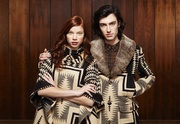
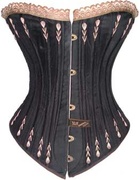 Everything You Know About Corsets Is False
Everything You Know About Corsets Is False
 Why the 'Native' Fashion Trend Is Pissing Off Real Native Americans
Why the 'Native' Fashion Trend Is Pissing Off Real Native Americans Everything You Know About Corsets Is False
Everything You Know About Corsets Is False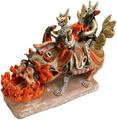 Diablitos in the Details: The Curious Tale of Mexico's Most Peculiar Pottery
Diablitos in the Details: The Curious Tale of Mexico's Most Peculiar Pottery Womens Clothing“Clothes make the man,” said Mark Twain. “Naked people have little or no in…
Womens Clothing“Clothes make the man,” said Mark Twain. “Naked people have little or no in… Mari Tepper: Laying it on the Line
Mari Tepper: Laying it on the Line Nice Ice: Valerie Hammond on the Genteel Charm of Vintage Canadian Costume Jewelry
Nice Ice: Valerie Hammond on the Genteel Charm of Vintage Canadian Costume Jewelry How Jim Heimann Got Crazy for California Architecture
How Jim Heimann Got Crazy for California Architecture Modernist Man: Jock Peters May Be the Most Influential Architect You've Never Heard Of
Modernist Man: Jock Peters May Be the Most Influential Architect You've Never Heard Of Meet Cute: Were Kokeshi Dolls the Models for Hello Kitty, Pokemon, and Be@rbrick?
Meet Cute: Were Kokeshi Dolls the Models for Hello Kitty, Pokemon, and Be@rbrick? When the King of Comedy Posters Set His Surreal Sights on the World of Rock 'n' Roll
When the King of Comedy Posters Set His Surreal Sights on the World of Rock 'n' Roll How One Artist Makes New Art From Old Coloring Books and Found Photos
How One Artist Makes New Art From Old Coloring Books and Found Photos Say Cheese! How Bad Photography Has Changed Our Definition of Good Pictures
Say Cheese! How Bad Photography Has Changed Our Definition of Good Pictures Middle Earthenware: One Family's Quest to Reclaim Its Place in British Pottery History
Middle Earthenware: One Family's Quest to Reclaim Its Place in British Pottery History Fancy Fowl: How an Evil Sea Captain and a Beloved Queen Made the World Crave KFC
Fancy Fowl: How an Evil Sea Captain and a Beloved Queen Made the World Crave KFC
I’ve always been a Kahlo fan and love the new and very personal information in this article. She was definitely ahead of her time and I’m thrilled that Henestrosa has produced this outstanding exhibit. Thank you for capturing a little of the heart of a very beautiful woman who has influenced millions.
I am touched to read with such depth about this woman. I have never thought more of fashion than I do after reading this. I hope our soldiers returning from Afghanistan etc have the courage and strength Kahlo had.
Let’s pretend for a minute that someone has absolutely no idea who this artist who died in 1954 was. Maybe you should tell a little about her in the first couple paragraphs. I have no idea who she is. Read the first 10 paragraphs and still had no idea other than she had some debilitating physical issue that I’m still not sure what that was either.
One of the most important 20th century artists. I love her. Thank you for sharing.
The link to the Museo Frida Kahlo, second sentence, second paragraph should leave no doubt who Ms. Kahlo was. Maybe it was a slight oversight not to mention that within the text, but for most people it would be akin to explaining who Pablo Picasso or Salvadore Dali was. Excellent article about one of my all time favorite artists.
What perfect timing! I just read this article yesterday and today I received information via email about an exhibit that is opening this weekend at the High Museum here in Atlanta entitled “Frida & Diego: Passion, Politics, and Painting”… I can’t wait to see it!
Wow…I was captivated by your article on the discovery of Frida’s personal items as well as new insight into her personal life. She’s Iconic! I would love to see this exhibit. Will it ever come to Australia?
I Stumbled in this article, with the intention to get just One Foto for a design i decided to make, But I’m Glad I Did, this is a Really amazing article, i haven’t seen most of these things before, and though the bits and pieces i read and watched about Kahlo’s Life made her a very special woman to me, This Article sort of glorified her Human side! Personally I’m touched!
Thank you for sharing this interesting information about Frida.
beautiful inside & out, thank you for this piece and for those curating such intimate pieces with reverence. such a will to power she had!
Captivating! Will the exhibit ever come to Chicago?
Great article and very useful for me! I first learned about Frida Kahlo in college (I was a Spanish major) and I’ve always loved her and her paintings. This Halloween I’m dressing up as her and this article gave me some great ideas. :)
Prachtige boeiende tekst ,geschiedenis Frida Kahlo heeft me echt aangegrepen zou er ooit ook een tentoonstelling komen in Bussel of een andere stad in Belgie?
Thank you so much for this wonderful article. Love Frida !! Style has always been such an intrinsic part of her- another way she took a recipe of ills and made it spectacular.
She had the courage to paint women’s pain, which must never be revealed in patriarchal warrior societies. Yet she was true to her longing, as a female, to create beauty even out of an imperfect female body. Viva Frida! I visited Casa Azul, and everything I see and read about her still touches the deepest core of my feminine soul.
Thank you for such a wonderful article! I would love to see the exhibition!
Her father was Hungarian (Jewish) not German.
Thank you so much for this beautiful and very interesting article.
I’m fond of Frida, her paintings and her poetry that sings Angelique Ionatos : http://www.emmacollages.com/article-valentine-merci-pour-frida-et-angelique-101807879.html
Her soul and courage are tremendous.
That was great, thank you for sharing!
“There is beauty in suffering”- what a fantastic exhibit. xo Frida
Love the look of this show, and so happy it has come about. The traditional Tehuana dress though (and I have been in Tehuantepec) consists of the skirt, the waist length huipil and the huipil grande, the white lace piece worn over the shoulders or surrounding the face as in some of Friday’s self portraits, apparently developed from a Child’s christening dress legend has it was found in a trunk from a shipwreck some couple of hundred years ago. This is worn only for very special occasions, as are many other interesting forms of head gear. For everyday wear, it’s just braids, as often as not if you work in the market, so you can carry stuff on your head. Even iguanas, as in Graciela Iturbide’s famous photo. Today, you will see young women in jeans with the huipil to maintain the tradition. In an everyday huipil, the chain stitching is always done with a sewing machine and has been since the 19th century. In 2006 you could get a lovely one for fifteen dollars in the market in Juchitán (the second main city of the isthmus). Hand embroidered flowers between the chain stitching squares added about five bucks.
Wonderful article.
To the gentleman who feels that you should have included more about who Frida Kahlo was? For God’s sake google her, look her up, strive to learn something. This man is intellectually lazy. Pay no attention to such an imbecile.
I saw an exhibition about Frida Kahlo & Diego in San Francisco,. but it lacked the clothing, etc. Perhaps the Legion of Honor would consider a Frida Kahlo exhibition from this exhibition that would have her clothing and other objects from her life.
My husband and I are tremendous Frida fans. He has the unbroken to prove it. Is there a catalogue or printed work of this exposition of her clothing?
Hi Dede ~ Here’s a link to the book of photographs taken by Ishiuchi Miyako:
http://www.michaelhoppengallery.com/store/publications/30/ Enjoy!
I too broke my back. Reading this makes me sad. I had to wear a plaster corset while my back healed. It wa hard. I was sixteen. Poor Frida. She suffered so. I hope she is in a pain free place wearing pretty clothes.
I initially responded with disdain to the man who had never heard of Frida; I confess that I felt an instant visceral disgust. But it’s wrong to be so judgemental; not everyone is borne with an innate love of art or a spirit of curiosity. One easily can feel superior. But have a heart, folks, many people’s lives are bereft of art and it’s very sad. Share your love of art with others including also the desire to create art of one’s own!
Frida Kahlo’s clothes, jewellery, makeup and a defiantly red-leather-booted prosthetic leg is in museum V&A in London. Frida is called by many as a countercultural and feminist symbol.
why is there no mention of her early years dressing in male attire… pant suits and ties… even her style of hair?